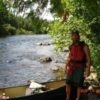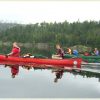Water Treatment and the Microorganisms that Hate It
Water, water everywhere / Nor any drop to drink
Water Treatment and the Microorganisms that Hate It
Sitting in your canoe on a hot July afternoon, the sun beating down, perched above a muddy creek, it’s easy to fathom the distress of Samuel Taylor Coleridge’s Ancient Mariner. Whether on the Mississippi or in Woodland Caribou Park there is water everywhere, but it is teeming with tiny microorganisms that may be parasites lying in wait. Many old-school paddlers will drink straight from the lake, but others are more cautious, and sometimes it just depends on the situation. Here are several ways of gauging water quality, and then making it potable.
Taking the Plunge
The “dip and sip” method is as old as time, and many paddlers today will still drink straight from the lake, but they recognize the threats to their intestinal well-being. The most familiar culprit is Giardia lamblia, whose symptoms appear 1-2 weeks after infection, and are basic signs of intestinal distress, including diarrhea, gas, and stomach cramps. Other common waterborne parasites, such as Cryptosporidium, have the same symptoms, but may set in faster. Although most people with healthy immune systems will recover naturally after two to five weeks, there are prescription medicines available to treat these diseases. The last threat is the tapeworm, which is a problem at Isle Royale, but is thankfully absent from most other canoeing destinations.
Giardia is by far the most common waterborne parasite in North America. Also known as “beaver fever,” it is transferred via animal excrement and, more and more, human fecal matter. Consequently, the more populated an area, the higher the likelihood that you will contract Giardia from untreated water. This is also why Leave No Trace practices for going to the bathroom in the woods are essential to preventing such contamination.
Moving and shallow water keep Giardia and other parasites suspended at fill level, so lakes are safer than streams, and still pools safer than moving water. Even if you treat your water it is better to go to the center of the lake than stay at the edges. There the protozoa have hopefully settled to the bottom, along with debris that can clog a filter. The habits of protozoa are not guaranteed, however, and even those who treat their water have been known to come down with dehabilitating diarrhea—so if you decide to go straight to the source, keep in mind the risks you are taking.
Water Treatment Options
You can easily prevent these maladies by treating your water. Now for the big decision: chemical or physical purification, or what combination? Chemicals kill the beasties and filters create a barrier through which they cannot pass. Water filters also catch tapeworm eggs that go unaffected by chemicals, but they do not catch viruses. Water purifiers use a filter in conjunction with a chemical or electrostatic process to clean water of protozoa and viruses. Some newer products don’t fit into either category, but rather use UV rays or a salt solution to treat the water. Which method you choose depends on what kind of tripping you will be doing, and largely upon personal preference.
Most people fall into one camp or another: filter fanatics or pill poppers. Iodine tablets are quick and easy, but long-term consumption of iodine isn’t good for your health and most find the taste repugnant. Carbon Dioxide treatments eliminate those problems but take four hours. Water filters are safe and chemical-free, but they can be slow and malfunction easily. As for a water purifier, it will be key if you travel to countries where viruses are prevalent, but in North America you don’t usually have to worry about taking that extra precaution. Examine the manufacturer specifics for their products for the answers to these key questions: What does the treatment destroy? How long does it take? and How does the result taste?
If you decide to filter, you will have to first decide what medium the cartridge uses, and thus how durable and easy to maintain it is. Most importantly your filter should have an absolute pore-size of at least .2 microns to actually be effective. Then you can consider the external features of the pump (size and comfort), but also how efficient the flow is. A low-volume glass-fiber filter will work for shorter trips with fewer people, but for group expeditions a ceramic filter will last longer and is easier to clean in the field. Still, you will also want to bring spare filters and hoses in case of malfunction. As with any gear, it is a good idea to go to a store or borrow a friend’s and see for yourself how it works.
The final way to treat your water is to boil it, which though sometimes impractical, is always effective. If you decide to boil your water, or if you must, bringing it to a boil is usually sufficient to kill most protozoa, but boiling for at least 2 minutes will kill even tape-worm eggs and ensure your water is sterile.
The beauty of canoe tripping is that you are indeed surrounded by beautiful, pristine water, and regardless of whether you treat it or not, it is still some of the purest water on Earth. If you decide to drink from the lake, revel in the fresh and easy feel of it, but know that you always do so at your own risk. The guidelines here are not guarantees, so for most folks the old adage is true: better safe than sorry—if the water seems sketchy, don’t prove it, just treat it.

Moving and shallow water keep Giardia and other parasites suspended at fill level, so lakes are safer than streams, and still pools safer than moving water. Even if you treat your water it is better to go to the center of the lake than stay at the edges.
![]() Water Filters/Purifiers
Water Filters/Purifiers










